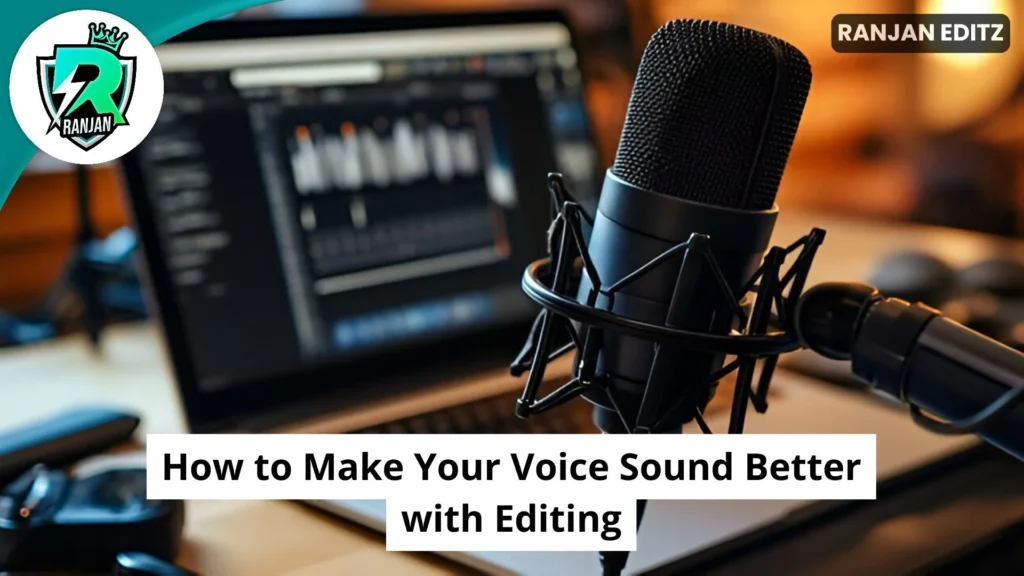The modern technological age demands clear professional voice quality for the rise of podcasts YouTube videos and audiobooks. The ability to enhance your voice through editing stands as a crucial competency for anyone from content makers to voice performers to audio quality improvers. The correct combination of techniques and available tools enables users to upgrade ordinary recordings into professional quality outputs.
Table of Contents

Voice editing stands as a crucial element for enhancing recorded audio.
The initial voice recordings tend to exist with background noise together with irregular volume patterns along with various production faults. Voice editing skills enable you to fix these audio problems so your recordings achieve top-tier professional quality. A proper editing process enables clarity while sustaining audience involvement to create an excellent listening experience.
Essential Tools for Voice Editing
A successful editing process requires proper selection of essential tools to begin with. To enhance your audio you should use this standard set of software and equipment:
- Makers of Audacity and other audio editing software including Adobe Audition and GarageBand and Reaper provide various tools for voice editing functions.
- The use of a high-quality condenser microphone eliminates excess editing since it records clear precise sound details.
- Pop Filters serve as tools which minimize plosive noises within your recording.
- Studio-quality headphones enable detection of any small audio problems that might exist.
Step-by-Step Guide on How to Make Your Voice Sound Better with Editing
1. Record in a Quiet Environment
A well-recorded quality audio remains essential because editing tools can correct many issues but not all of them. Find a quiet environment to record your voice since this practice will reduce the amount of editing work necessary afterward.
2. Remove Background Noise
Audio editing software packages come equipped with standard noise reduction functions. You can make Audacity automatically remove background noises after selecting silent audio segments followed by ‘Noise Reduction’ application.
3. Normalize Audio Levels
Distracting acoustic changes happen when volume levels remain irregular. The audio normalization feature available in your editing program makes sure your recording maintains an uninterrupted even volume level.
4. Equalization (EQ) Adjustments
Reducing audio distortions requires equalization as an essential step to enhance the sound quality of your voice in editing processes. Voice clarity gets enhanced through equalization which permits boosting or reducing predetermined frequencies. Here’s how:
- A mild increase in high frequencies will enhance the brightness of the audio signals.
- You should lower the frequency range when your recorded voice has pronounced boomy tones.
- You should change mid-frequency levels for warming up your voice.
5. Compression for Consistency
The compression technique smooths volume distribution because it lowers high peaks while raising lower sounds. The sound quality becomes more balanced and professional.
- Program the system to activate compression once the audio reaches a specified point.
- The reduction level depends on your adjustment settings for the ratio parameter.
- You should adjust the attack and release controls to modify the impact of the effect.
6. De-Essing to Reduce Harsh Sounds
The combination of severe ‘s’ and ‘sh’ sounds during speaking has the potential to become distracting for listeners. The voice becomes more pleasurable through de-essential tools which reduce harsh sounds in your voice.
7. Add Reverb and Effects Sparingly
Using effects should be limited because excessive reverb application makes your voice sound artificial. Late effects should have minimal use because they add professional quality to your voice recordings.
Advanced Techniques to Make Your Voice Sound Better
Using a Noise Gate
The noise gate operation removes idle noises that occur during your non-talking periods. A properly adjusted threshold will let only your voice pass through the system.
Enhancing with Pitch Correction
Mild pitch correction applied to off-pitch audio will smooth tonality without producing robotic effects.
Layering Multiple Takes
Multiple voice takes layered one on top of the other creates deep authentic sounds in your voice.
Common Mistakes to Avoid When Editing Voice Audio
When working with voice editing methods to make your voice better there are particular mistakes which will damage your output results.
Using effects excessively such as reverb and compression and excessive EQ adjustments results in unnatural vocal sound.
Editing does not provide solution to issues related to poor room acoustics in the recording environment. Perform voice recording inside a space that offers controlled conditions.
Using substandard source audio at the beginning results in unusable output since poor input provides only poor results.

